Feline pet insurance installments will vary depending on several factors like what breed the cat is, age, gender, location, and the payment plan you choose. But is your fluff ball one of the 10 most expensive cat breeds to insure? It is quite possible because most of the members on this list are common breeds found in many homes.
For example, some cat breeds have heredity illnesses, which could incur more veterinary visits, medication, and medical expenses. Their age is also critical; older cats have higher insurance premiums. Therefore, the lowest installments are usually reserved for ages 1 to 6.
Gender is a factor too. Statistics show that male cats have more claims than their female counterparts. In fact, female cats save their owners 5% on pet insurance premiums.
Location is vital in determining how much cash you will have to cough up each month. Some veterinarians charge higher fees, and your insurance will account for that.
And lastly, your payment plan plays a huge factor. You will pay more monthly if you choose a high annual maximum with a low deductible. So, for example, if your plan has unlimited yearly coverage, 90% reimbursement, and a low deductible, your monthly installments will be much higher because the plan pays out more than the others.
Which begs the question –
What Are the Most Expensive Cat Breeds To Insure?
The following felines are the 10 most expensive cat breeds to insure in the world, and owning one won’t come cheap. They make this list because of health conditions, pedigree, rarity, and location.
1. Siberian Forest Cat $457 per month

Siberian cats are prone to a disease called HCM (hypertrophic cardiomyopathy).
©iStock.com/marieclaudelemay
Siberian Forest cats also go by the name Moscow longhairs or Siberian cats. They are a medium to large breed with long, fluffy coats and massive bodies. The males’ average weight ranges from 15 to 20 pounds, while females are slightly smaller.
These cats are vigilant, powerful, playful, and curious. They are a landrace breed which means they have adapted over time to their surroundings. That’s why they have such thick, warm coats; they needed one for the icy Russian winters.
Due to their laid-back personalities and surprisingly easy maintenance, the Siberian forest cat is a great addition to large households with many kids and other pets.
Health
These felines can live for 8 to 10 years and are generally healthy cats. However, they are prone to a disease called HCM (hypertrophic cardiomyopathy). This condition enlarges the heart muscle, causing it to become less functional.
That’s why it is essential to ensure you are only purchasing purebred cats from reputable breeders. This is because they screen for health issues throughout the breeding pair’s lives to ensure they are healthy.
2. Bengal $404 per month
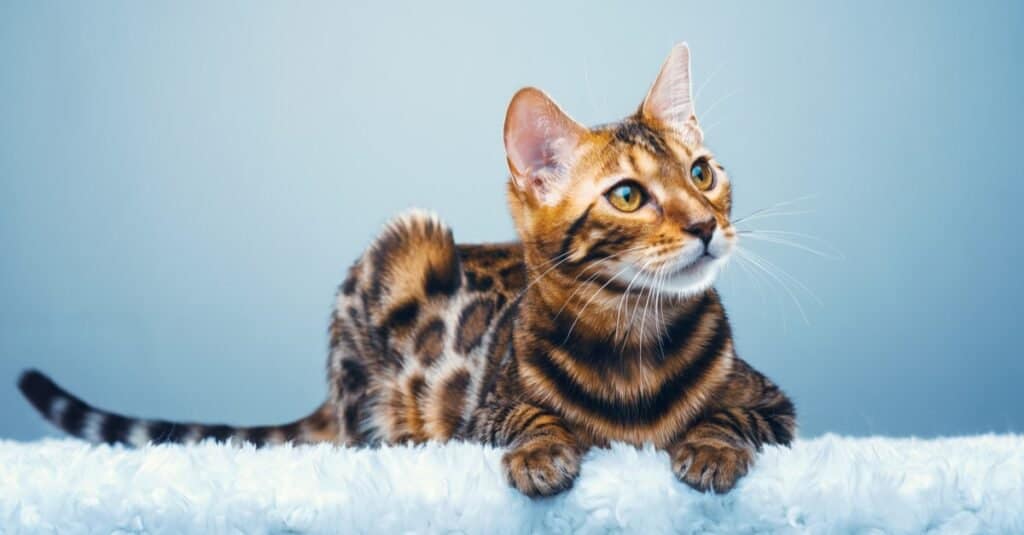
Bengal cats come in colors like silver, brown, and snow and have
fur as soft
as a bunny.
©Cressida studio/Shutterstock.com
Bengal cats are an agile large-sized breed that typically weighs between 8 to 15 pounds. They are a popular choice amongst cat lovers because of their thick, short coats covered in rosettes, similar to a leopard, with stripes on their legs, like that of a Bengal tiger.
They come in colors like silver, brown, and snow and have fur as soft as a bunny. Their coat makes them unique because they are the only domestic cat breed with rosettes inherited from their wild Asian leopard genes.
However, some members of this breed have spotted or marbled coats, which are also in demand and are absolutely breathtaking. Due to the length of their fur, Bengals only require a thorough brush once a week; this will remove any loose hair or dead skin cells.
Health
These cats are generally healthy and can live between 9 to 15 years. But, as with most domestic breeds, they are prone to three severe health issues, which is why Bengals are ranked one of the most expensive cat breeds to insure. If you have a Bengal cat, there are 3 health problems you should always be on the lookout for:
Anesthetic Allergies
These cats can be highly sensitive to anesthetics, which can be a big and expensive problem if they ever need surgery; this includes sterilization. In addition, their reaction might be so severe they could suffer from cardiac arrest!
Heart Disease
Bengal cats may suffer from HCM (hypertrophic cardiomyopathy), which causes the heart muscle to thicken. This illness predominantly affects older dogs and can lead to blood clots, heart failure, or a shorter lifespan.
Eye Disease
Unfortunately, Bengal cats are prone to an eye condition called progressive retinal atrophy. This disease causes significant deterioration of the retina and eventually blindness.
3. Ragdoll $381 per Month
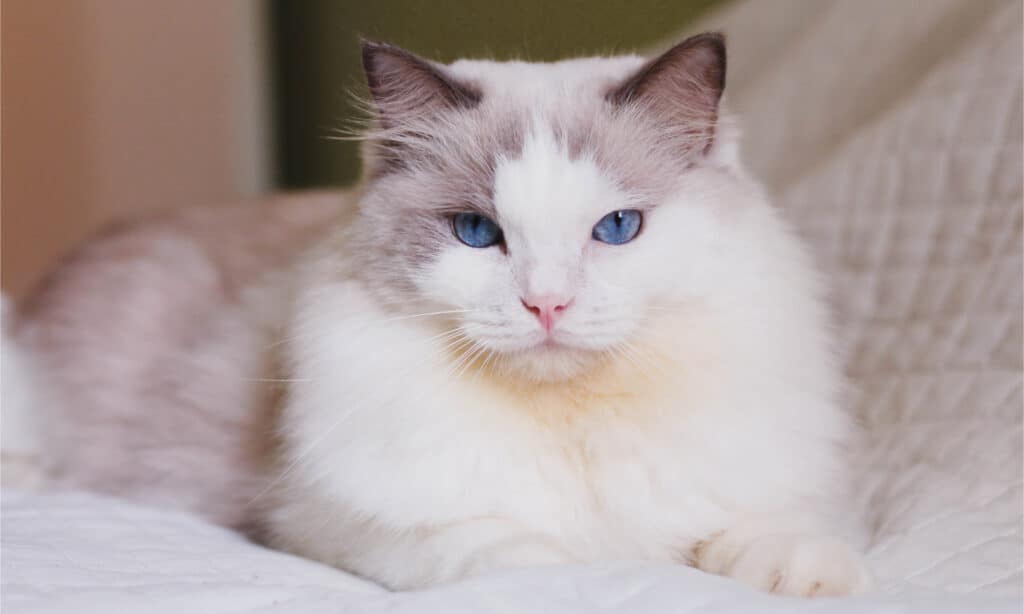
Ragdolls are a relatively new breed, which makes their genetic pool very small.
©Amanda Almeida/Shutterstock.com
Ragdoll cats are a large breed known for their gentle, loving, and patient nature. Although massive, this breed is quite laid-back but with a playful and cuddly side. These cats make great family members and thrive around children. They enjoy a lot of attention and extra rubs whenever they can get them.
Ragdolls are a relatively new breed, which makes their genetic pool very small. As a result, irresponsible breeders are responsible for inbreeding these cats, which leads to numerous medical conditions.
Health
If these fluffy felines are bred responsibly, and no inbreeding has occurred, they can live really long lives, about 13 to 18 years. However, Ragdolls are susceptible to a few health issues like HCM and Urinary tract issues, which can cause bladder stones that require surgery to remove.
4. American Shorthair $376 per month
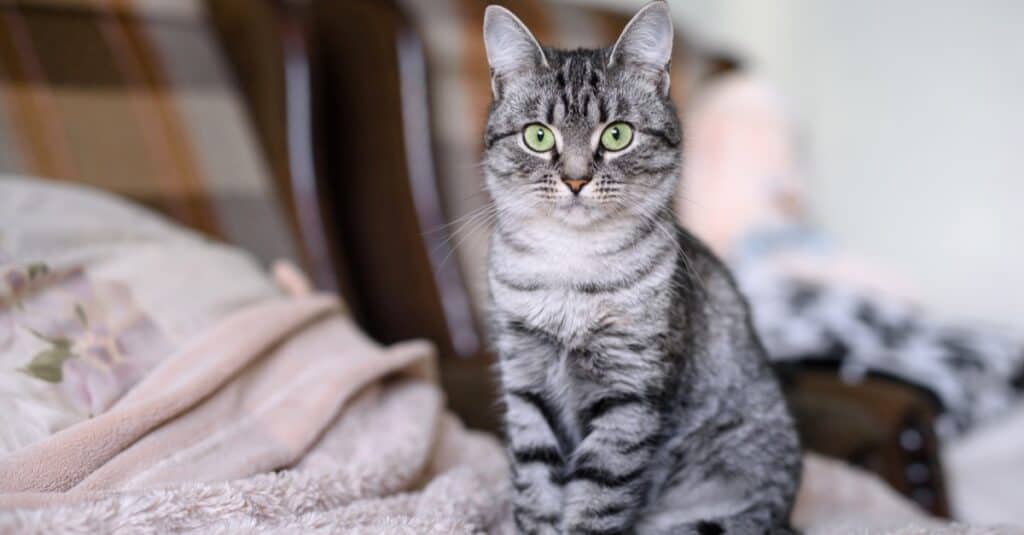
American shorthairs were used as protectors of grain harvests plagued by rats and mice.
©Lalandrew/Shutterstock.com
The American shorthair originated in Europe and arrived in the USA during the 1600s. They were used as protectors of grain harvests plagued by rats and mice. Farmers specifically selected this breed because of their sharp hunting abilities and soon started to breed them.
However, their playful and loving personalities soon made them a popular choice for domestic life, and the rest is history. They were quickly found in homes across the USA as an intelligent and affectionate companion.
Health
Because of their years spent as a working breed, the American shorthair is a sturdy and healthy breed. Their average lifespan is between 15 to 20 years, but they are prone to several health issues, including:
Heart Disease
Just like the former members of this list, the American shorthair is susceptible to HCM, which, if left untreated, can cause heart failure. That’s why taking your loving furball to the vet for regular checkups is essential.
Obesity
If this cat doesn’t get enough exercise or is fed too much, it can become obese, which leads to several severe health issues. American shorthairs should not be free-fed because they tend to overeat. Instead, feed them two to three small meals a day.
Renal Failure
The American shorthair is prone to renal failure, causing its kidneys to shut down and stop filtering waste from its blood. Unfortunately, older cats seem more susceptible to this illness than younger felines. This is why they are one of the most expensive cat breeds to insure in the world.
5. Maine Coon $374 per month

The Maine Coon is the longest cat in the world.
©iStock.com/mstudeny
The Maine coon is a massive cat breed notorious for its loving and social personalities. Their giant bodies can measure up to 40 inches long, and a male’s average weight is between 15 to 20 pounds!
Maine coons are ranked one of the most desired cat breeds in the world and were the fifth most-purchased breed in America in 2019. However, this does not dilute their price. Maine coons can cost anywhere between $400 to $1,500, depending on the breeder’s reputation, location, pedigree, and gender.
Health
When cared for properly, these cats have a lifespan of 10 to 13 years. But there are some health issues you should look out for, like hip dysplasia and arthritis. In addition, they could suffer from HCM like many other breeds on this list. However, if you buy a Maine coon from a reputable breeder, they will screen for any health concerns in all their kittens and breeding pairs.
6. Russian Blue $369 per month
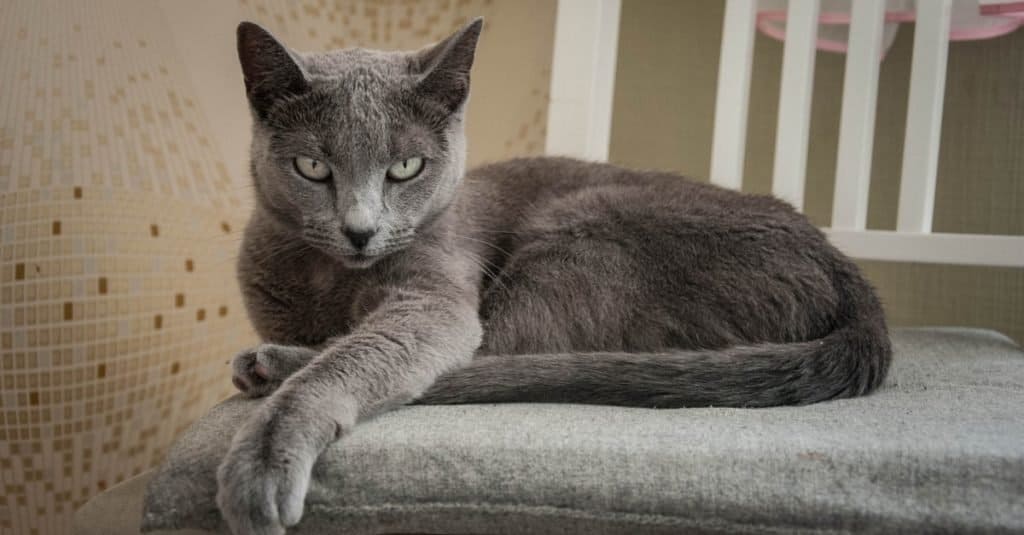
Russian blues are known for their thick, gorgeous blue-gray coat and bright eyes.
©palllna/Shutterstock.com
The name says it all; this cat is in demand because of its spectacular blue-gray coat that enhances its piercing green eyes. They are faithful companions that get stuck in their ways because they love routine.
While Russian blues are affectionate cats, they have an independent streak and don’t require a lot of grooming because of their short coat. This makes them perfect for families with older children.
However, they can be quite shy, so it requires patience and a gentle hand to bring them out of their shells. These cats are relatively common in the United States, so their price can vary from $400 to $600.
Health
With the proper care, Russian blues can live between 15 to 20 years and are generally considered healthy cats. However, there are a few conditions that commonly occur in this breed.
Russian blues are enthusiastic eaters and pick up weight quickly. Obesity is a serious problem in this breed, and owners should strictly monitor their diets at all times. In addition, these cats can develop PRA (progressive retinal atrophy). This disease causes damage to the retina and eventually leads to loss of site.
Lastly, they can suffer from PKD (polycystic kidney disease), where groups of cysts develop in the kidneys, causing them to enlarge and stop functioning. It is a genetic disease and can be prevented by breeding healthy cats who have been screened for this condition.
7. Siamese $327 per month
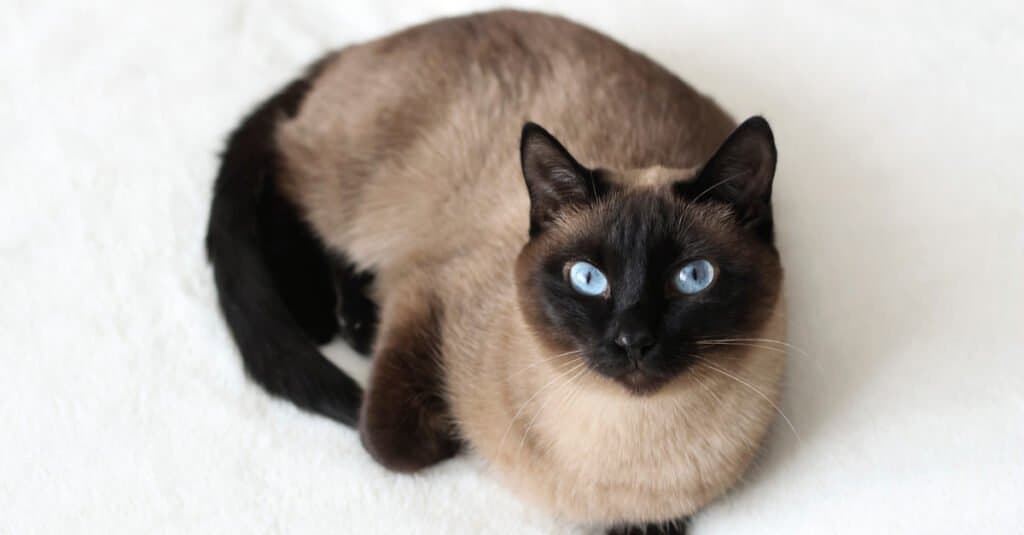
Siamese cats are very intelligent and charming.
©Linalyan/Shutterstock.com
There was a time when Siamese cats were all the rage, but with easier access to more exotic breeds, you hardly ever see them anymore. And it’s a pity because they are very intelligent and charming. However, their need for constant attention makes them almost dog-like in nature.
But their loving and loyal personalities make them the perfect pet for singles or seniors who have a lot of love to give.
Health
These curious kitties can live for 15 to 20 years, which is long for a cat. But Siamese cats are prone to a few health issues like:
- Asthma
- Amyloidosis (liver disease)
- Cancer
- Dental disease
While reputable breeders screen for these conditions, they may show up later in life, so you must take your Siamese cat for regular vet checkups.
8. Sphynx $326 per month
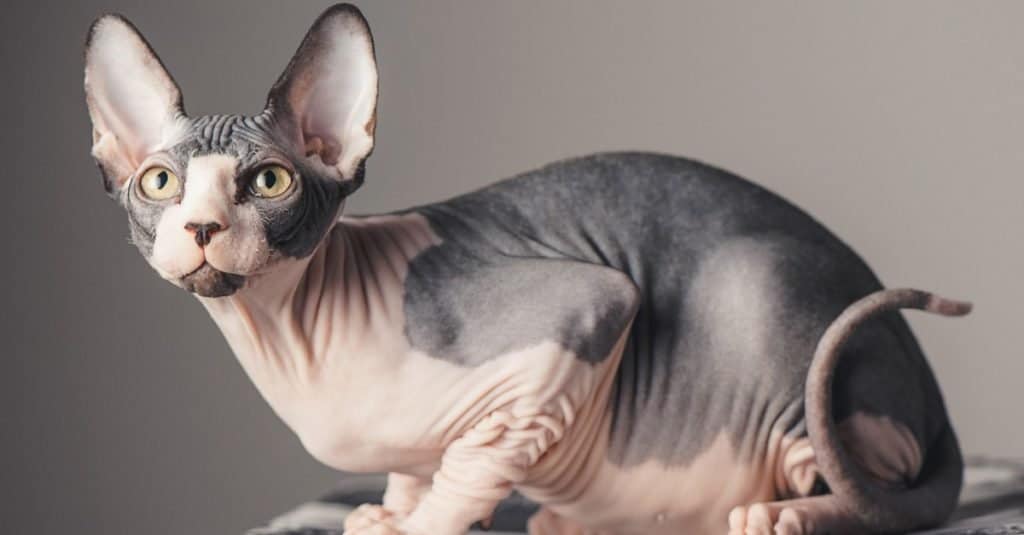
The Sphynx cat is known for being clingy. And they are happiest when they are in the presence of their owners.
©Yuryi Oleinikov/Shutterstock.com
It’s not hard to spot a Sphynx cat due to its bald body. While some people are put off by their looks, many cat lovers worship this breed, which is notorious for its wacky and engaging nature. In addition, they are extremely intelligent and loyal.
Sphynxes make great family pets and are great with children because of their loving and friendly personalities. However, they require a lot of attention and can sometimes become needy. These cats are quite rare, making them one of the most expensive cat breeds. They can sell for $1,500 to $6,000 depending on the breeder’s reputation, location, pedigree, and gender.
Health
The Sphynx has an average lifespan of 9 to 15 years, but they are still susceptible to a few health problems like:
- Skin issues due to their lack of hair (greasy and oily skin)
- Heart Disease (HCM)
- Hereditary myopathy (Muscle disease that can affect their walking)
Because they don’t have a lot of hair to absorb the natural oils on their skin, Sphynx cats need a bath once a week, which should be fun.
9. Persian $317 per month

Persian cats
require thorough brushing daily to prevent their flowing coat from knotting and matting.
©iStock.com/pavels
The Persian is one of the most sought-after cat breeds in the world and has been around since the 1600s. It’s hard not to love this breed with its long, soft coat, chubby bodies, and squished faces.
They are a medium-sized breed known for their loving nature, never one to turn down attention and cuddles. Persians come in several colors: cream, red, blue, black, smoke tortoiseshell, and blue-cream smoke.
However, their grooming schedule is no joke. They require thorough brushing daily to prevent their flowing coat from knotting and matting.
These cats can cost anywhere from $500 to $1,800 from a reputable breeder. However, sometimes people get lucky and find them at a shelter or rescue. But, the price of purebreds can skyrocket to over $3,000 if the cat has show or breeding potential, which is why it tops the list of most expensive cat breeds in the world.
Health
If Persians are cared for properly, they can live between 10 to 15 years. But, as with all domestic cats, they are susceptible to a few health conditions and should be monitored closely for any symptoms.
Their most common ailments are PKD (polycystic kidney disease) and PRA (progressive retinal atrophy). PKD causes kidney failure and is a hereditary disease. On the other hand, PRA causes blindness because it damages the retina.
In addition, Persians generally suffer from numerous eye and dental issues because of their flat faces and shortened jaws, so keep special attention on these areas.
10. Himalayan $287 per month
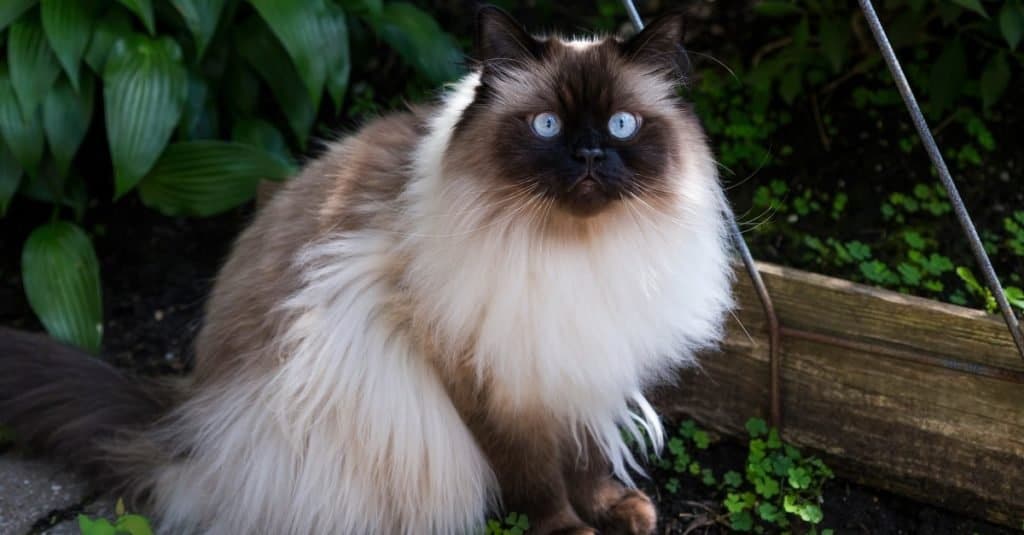
The average lifespan for Himalayan cats is 12 to 15 years.
©Anne Richard/Shutterstock.com
The Himalayan cat is a gorgeous mix between a Siamese and a Persian and is a popular breed for movies, like Sassy in Homeward Bound and Mr. Jinx in Meet the Fockers. They inherit their long, silky coat from the Persian cat. And from the Siamese, their beautiful coloring, and Saffire blue eyes.
In addition, they are also described as dog-like because of their affectionate, laid-back, and loyal nature, which is why they are such good candidates for movies.
Health
The average lifespan for Himalayan cats is 12 to 15 years, but because they inherit genes from two different breeds, they are susceptible to several health problems. Because they have long fur and shed a lot, they are prone to hairballs, which is another reason they need to be brushed every day.
In addition, they can suffer from PKD (polycystic kidney disease) and PRA (Progressive retinal atrophy). Lastly, they are prone to feline hyperesthesia syndrome. This neurological disorder causes the cat to severely bite and lick certain areas of their bodies, predominantly their backs, limbs, and tails.
This illness is highly stressful for your feline friend, but luckily it is treatable, but unfortunately, it is incurable.
Related Articles
- The 15 Most Expensive Cat Breeds
- Serval Vs. Savannah Cat: Key Differences and Who Would Win in a Fight
- Even More Types of Exotic Cat Breeds
The photo featured at the top of this post is © iStock.com/Louis-Michel DESERT
Sources
- Pawlicy Advisor, Available here: https://www.pawlicy.com/blog/which-cat-breeds-need-pet-insurance/
- Pawtracks, Available here: https://www.pawtracks.com/getting-started/dog-and-cat-breeds-with-most-expensive-vet-bills/
- Forbes Advisor, Available here: https://www.forbes.com/advisor/pet-insurance/best-pet-insurance/#dog_and_cat_breeds_with_the_highest_vet_bills_section
FAQs (Frequently Asked Questions)
What is the most expensive cat breed to buy?
The Ashera is the most expensive breed of cat in the world, costing up to $125,000. This breed is a mix between aServal, Asian leopard, and a domestic cat.
What is the number 1 cat breed?
Persian cats are not only the most sought-after breed of cats but have also been around longer than most breeds since the 1600s.
Is insurance for a cat worth it?
Yes! You never know what is going to happen to your furry friend. Pet insurance will help pay for any unexpected emergencies.
Thank you for reading! Have some feedback for us? Contact the AZ Animals editorial team.






